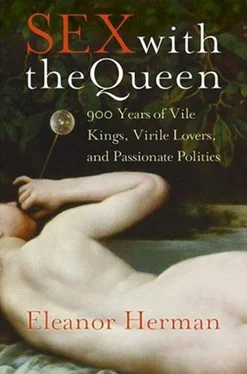When imagining the life of a princess bride, we envision opulent rooms boasting every comfort, efficient servants carrying out her every whim, a wardrobe of luxurious gowns, and a jewel box bursting with sparkling gems. We can hear the sweet strains of violins at a candlelit ball, smell the aroma of succulent roasted meats at the banquet table. We picture her handsome loving husband, her growing brood of healthy children, and envy her.
And yet the queen was often chained to a husband who didn’t want her, didn’t even want to sleep with her. Her children were taken out of her control and raised by palace officials as property of the state. She was forced to stand by patiently while doctors killed her children by bleeding them to death.
Her servants were often spies in the pay of her enemies. Nor was her life what we would call physically comfortable, let alone luxurious. For several months a year, drafts sliced through palace rooms like knives. Rats and insects nested behind gilded walls. Nor was the queen consort necessarily rolling in money; she possessed only the funds which her husband chose to bestow upon her—in some cases, nothing.
Until the mid-nineteenth century when travel became easier, the princess sent off to wed a foreign monarch would likely never see her family again. The childhood friends and devoted servants she brought to her new country caused jealous intrigues and were often sent home as meddling intruders, leaving the princess alone and friendless.
Perhaps we will begin to comprehend why a decent God-fearing woman, cast upon a foreign shore bereft of family and friends, might jump into an adulterous affair, might seek a little love and understanding in the midst of her misery.
The beauty of royal lodgings increased with the centuries. The medieval queen spent most of her time in the great hall, a large dark chamber with slits for windows and an enormous hearth. Meals were served here, and in between meals the queen sewed with her ladies and met with subjects seeking mercy or justice. But she was not alone in the hall; also present were the rest of the royal family, the entire court, bustling servants, and flea-bitten dogs hunting for food scraps on the rush-covered floor. There was scant furniture, and that was uncomfortable—tables, benches, and, for the queen, a stiff high-backed chair. Vivid tapestries covered the stone walls but did little to dispel the gloom.
By the Renaissance, a European queen had her own suite of small, cozy wood-paneled rooms with large windows and heavy ornately carved furniture. In the baroque period, royal rooms boasted high ceilings painted with mythological scenes, gilded walls, silver-framed mirrors, and gleaming parquet floors. The dainty furniture was covered in silk or satin. Yet despite the ever-increasing grandeur of royal suites, life in the palace remained profoundly uncomfortable.
Catherine the Great, who arrived in Russia in 1744 as a German bride for Empress Elizabeth’s nephew and heir, suffered terribly from the cold. Russian winters, so hard on peasants, were often not much easier on royalty. Churches were unheated, and many of the palace rooms were drafty and cold despite the presence of a crackling fire. Windows did not close properly, letting icy arctic winds howl through the rooms. Many days Catherine was “blue as a plum” and numb from the cold. 1She frequently suffered colds and fevers.
At night she was often kept awake by the sounds of rats scuttling behind the walls. Once, when a palace caught fire, Catherine stood outside in the street watching thousands of black rats evacuating the palace in an orderly fashion, followed by thousands of gray mice. She was not sorry to see that palace go; in addition to the rats and mice it had been “filled with every kind of insect.” 2
In the 1660s, utilizing daring feats of engineering, experts transformed a hunting lodge in a swamp into glorious Versailles Palace with an impressive system of fountains and canals. Yet for all the engineering advances of the time, no one had come up with the simple idea of window screens. Open windows allowed in a pleasant breeze, to be sure, as well as birds, squirrels, bats, and insects.
“The confounded gnats here do not let me have an hour’s sleep,” opined Elizabeth Charlotte, duchesse d’Orléans, from her gilded Versailles apartments in 1702. “They have chewed me up so much that I look as if I had smallpox again. We are also plagued with wasps,” she added. “Not a day goes by that someone is not stung. A few days ago there was tremendous laughter: one of these wasps had flown under a lady’s skirt; the lady ran around like mad because the wasp was stinging her high up on the thigh, she pulled up her skirt, ran around, and cried, ‘Help! Close your eyes and take it off!’” 3
Elizabeth Charlotte also suffered from the extremes of weather. “The heat is so great that the oldest people cannot say they have ever experienced anything like it,” she reported in July 1707. “Yesterday everyone kept to his room in his shirt until seven at night; one constantly had to change shirts; I changed mine eight times in one day, and it was as if they had been dipped into water. At table too people keep mopping their faces.” 4
“The cold here is so fierce that it fairly defies description,” she wrote in January 1709. “I am sitting by a roaring fire… and still I am shivering with cold and can barely hold the pen….The wine freezes in the bottles.” 5
Nor had palace sanitation evolved to a high level. In the early eighteenth century, the duc de Saint-Simon wrote, “The royal apartments at Versailles are the last word in inconvenience, with back views over the privies and other dark and evil smelling places.” 6
“How would it be possible to prevent men from pissing in the streets?” lamented Elizabeth Charlotte in 1720. “In fact it is a wonder that there are not entire rivers of piss, considering the huge numbers of people living in Paris.” 7But hygiene inside the palace was no better than in the streets. English visitors to Versailles were shocked to find the most elegant courtiers spitting on the floor and urinating in the corners.
Even life in a modern palace is not what we would imagine. The British royal family insists on cost-saving measures that would be laughed at by a middle-class family. In 1981 Diana, Princess of Wales, was baffled to find Her Majesty Queen Elizabeth II of Great Britain wandering around Buckingham Palace at night turning off lights to save on the electric bill. When the princess complained of the chilly rooms in the Scottish estate of Balmoral, the queen politely suggested she put on another sweater. When royal toes poke through socks, servants darn them rather than throwing them out and buying new. Dirty bedsheets are reversed to get both sides soiled before being laundered. And when Paul Burrell, who later became Princess Diana’s butler, started working at Buckingham Palace, he was given a musty uniform that had first seen service under George III, when he was fighting the American Revolution.
A princess usually discovered that her greatest discomfort was not the weather, or the insects, or the smell of human waste, or the puzzling thriftiness of her royal in-laws, but the husband she was forced to wed. The purpose of a royal bride was to produce royal babies. “I want to marry a womb,” said Napoleon. 8Other monarchs, though shuddering at the little Corsican’s indelicacy, would have agreed with his sentiments. A princess was valued primarily not for her education, her personality, her good works, or even her beauty, but for her uterus.
Because she was regarded as a body part rather than a person, a princess found that her feelings were usually disregarded. Politicians, pushing their candidates for groom sight unseen, tried to cram their selections down a princess’s throat. A Prussian minister, hoping to persuade Frederick the Great’s sister, Princess Wilhelmina, to accept a marriage candidate in 1727, grandly declared, “Great princesses are born to be sacrificed for the welfare of the state.”
Читать дальше












